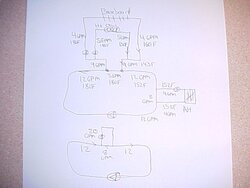Wow, not without a lot of bandwidth

Basically P/S s uses closely spaced tee to "tap off" the various loads, or add energy to a loop.
By doing so each load, and the primary loop is assured proper flow. Generally very small circs are all you need to move the various loads.
Here is a basic example of what happens. the primary loop is always moving 12 gpm. via closely spaced tees we are pulling off two loads. one is a baseboard loop requiring 4 gpm at 180F. the second is an indirect tank needing 5 gpm.
Notice the common piping between the tees now has a 3 gpm flow, as 9gpm is going to the loads. BUT the loop still flows 12 gpm, because whatever leaves a tee, must come back into a tee.
The 143F return from both loads blends with the 3 gpm 180F still flowing in the common piping to provide 152F to the next load or back to the boiler(s) Maybe the next load is an air handler requiring 4 gpm. It will get 152F, and with a 20 degree delta tee, return 132F back into the loop.
It is even possible for the primary loop to flow 12GPM and the loads pull 20 gpm. As the flow can reverse in that common piping between the tees.
No flow is moving in any branches or secondaries unless that circ is running. Flow rate is constant, all systems are hydronically balanced.
To have a true primary secondary piping there MUST be closely spaced tees!
If you see a drawing with a loop and the loads are taken off as parallel, that is one off the supply, and the other off the return, it's not primary secondary piping. The magic and the key is the closely spaced tees.
This article may help.
www.pmmag.com/Articles/Column/748dbf9d48fc7010VgnVCM100000f932a8c0_
If the link drops go to the archive October 2000 and look for John Sigehthalers article "Primary Proportions"
hr___


 Basically P/S s uses closely spaced tee to "tap off" the various loads, or add energy to a loop.
Basically P/S s uses closely spaced tee to "tap off" the various loads, or add energy to a loop.